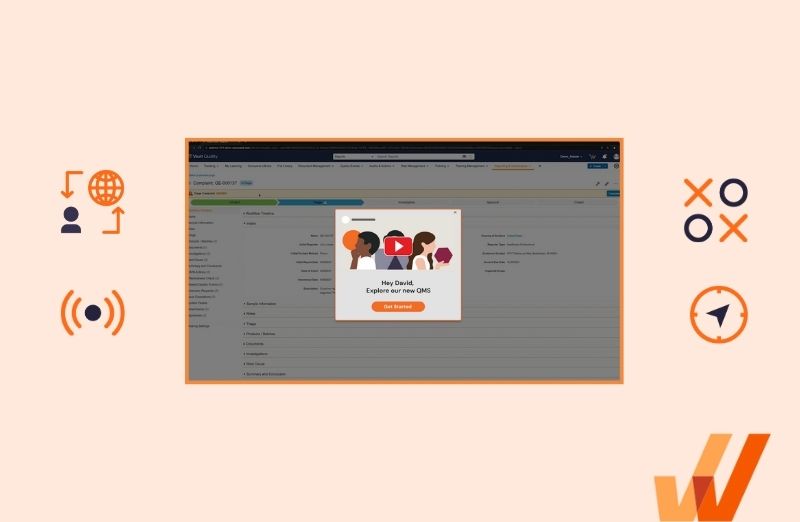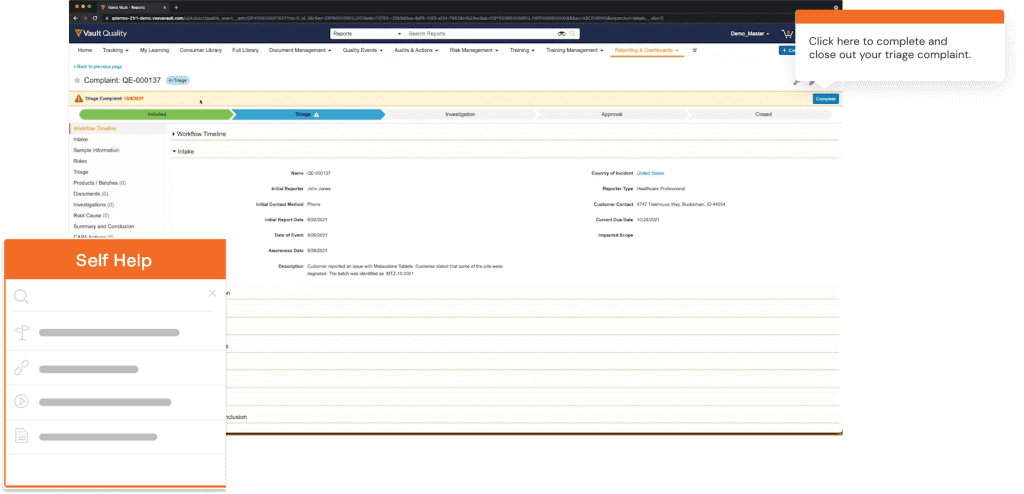
Levi Olmstead


Veeva Systems is an American cloud-computing company that builds software products for pharmaceutical and life sciences industry applications. It offers a wide range of industry-specific technology solutions for enterprise pharmaceuticals, biotech, and life science companies, such as:
But, perhaps, Veeva’s most significant USP for life science and pharmaceutical operators is its quality management (QMS) software suite that empowers its customers and end-users to manage and control their documentation, stay compliant with industry standards (e.g., GMP, i.e., Good Manufacturing Practices, GLP, i.e., Good Laboratory Practices, and GCP, i.e., Good Clinical Practices), coordinate their Corrective and Preventive Actions workflow, manage suppliers, and keep tabs on quality metrics.
Veeva QMS is designed to help life science and pharmaceutical companies manage their quality control and compliance processes more effectively. Veeva’s QMS is branded as Vault and we use both terms interchangeably throughout this article.
If you’re reading this, you’re on the cusp of investing in Veeva’s Vault QMS and this article will give you a handy guide to help you accelerate your QMS implementation and drive end-user adoption across your wider team.
To understand what it takes to implement a Veeva QMS instance successfully, you must start thinking backward – how can you inject technology into your organization’s existing workflows? Where can automation help you reduce error rates and ensure compliance?
That’s why your implementation strategy needs to start with front-line stakeholders, rely on an -in-depth knowledge of your existing processes, and be heavy on training and development to help your workforce use the platform to its full potential.
Life sciences, pharma, and biotechnology are heavily empirical fields—the bulk of the work is frontline research and there are few layers of managerial oversight and hierarchy. And those researchers will be dealing with your QMS, trying to align it with their existing workflows. Consequently, your QMS implementation journey needs to start with a consultation and engaging with these stakeholders to help you determine:
What are your goals for your Vault QMS implementation? Setting these targets, along with metrics for measuring success will help you determine how to customize your Vault QMS to suit your uses and any edge cases to account for.
Depending on your organization’s size, industry, or projects, you might be trying to:
Document your existing QMS-related processes, workflows, and SOPs in their current iterations, ranging from change control to Corrective and Preventive Actions (CAPA). Your goal at this stage is twofold: first, you want to examine all your processes, identify growth opportunities, and eliminate redundancies; secondly, you want to optimize them for a digital quality management workflow, especially to fit the parameters for Veeva’s Vault QMS.
Your organizational change strategy is your game plan for securing buy-in across the board, educating your team on why you’re switching to Veeva’s Vault QMS, and creating the infrastructure to ensure a smooth rollout. Among others, you need to:
During the transition phase, you’re trying to keep your day-to-day operations running (on your existing systems), while slowly navigating the core of your quality management ops to Veeva—almost like fixing an aircraft engine in mid-air. And that’s why you need a change management strategy: it helps account for possible disruptions and creates a minimally viable plan for mitigating them when they occur.
The human factor is easily the most unpredictable when working with enterprise software—especially when transitioning between different platforms. When you’re adopting a new quality management system, it’s doubly so: your employees are most likely invested in the software implementation process, advising on best practices, and helping design the vision for the new QMS, while attending to their regular day-to-day duties.
There’s the possibility that they might miss helpful information and thus not be able to use the platform to its full potential. Thankfully, there are countless approaches you can take towards investing in employee onboarding and continuous end-user training such as:
With a digital adoption platform (DAP) like Whatfix, IT teams can accelerate Veeva QMS adoption by enabling end-users with in-app guided onboarding flows and continuous interactive training right inside of the Veeva UI.

With Whatfix’s no-code editor, easily create contextual guided walkthroughs (Flows), in-app checklists (Task Lists), Pop-Ups, Field Validations, Smart Tips, Beacons, and more – all enabling your Veeva QMS end-users with interactive, contextual, moment-of-need support and reinforcement learning for different types of end-users, depending on their role and where they are in Veeva.
Software clicks better with Whatfix's digital adoption platform
Enable your employees with in-app guidance, self-help support, process changes alerts, pop-ups for department announcements, and field validations to improve data accuracy.
After your initial deployment, you can take your Veeva QMS a step further by integrating third-party product adoption tools like Whatfix to help you coach your end-users, offer contextual end-user support, embed helpful resources (wikis, product docs, FAQs) right inside your Vault QMS interface.
With a DAP like Whatfix, IT teams can provide real-time Veeva end-user support with Self Help. Self Help connects, crawls, and aggregates all of your organization’s online storage and drives, internal wikis, QMS-related process documentation, end-user onboarding and training materials, IT help desk and related knowledge articles, video and screen recording tutorials, third-party links and resources from Veeva, and more – and then organizes them in a searchable Self Help widget that overlays on your Veeva QMS’s UI.

End-users ranging from QA specialists to operations managers, to suppliers are the best proxy for measuring the effectiveness of your newly implemented QMS and vetting and where you need to make changes to fit your organization’s needs.
Feedback is essential during your initial beta launch of Veeva, allowing those end-users who are first interacting with your Veeva QMS instance to report bugs, provide feedback on the usability of processes, request additional training or support on different workflows, and more.
End-user feedback should be collected throughout the lifecycle of your new Veeva QMS investment and helps determine how to customize your QMS further and design your user training and onboarding programs to suit hands-on use cases better. It can specifically help answer the following Veeva-related questions:
With a DAP like Whatfix, CIOs and IT teams can create and embed in-app surveys to collect end-user feedback right inside Veeva QMS. This enables IT teams to collect qualitative feedback from real Veeva QMS end-users directly inside the application.

More than just quizzing your end-users to learn what they love and what they think could be improved, behavior analytics helps you observe their usage patterns, down to the features they use, pages they visit, and the UI elements they interact with within the Veeva ecosystem.
Using that data you can go a step further and accurately identify where your end-users face issues, common friction points, UI confusions, and usability challenges.
A product analytics platform like Whatfix helps IT teams understand how end-users are engaging, using, and adopting your new Veeva QMS investment with user behavioral analytics.
This data-driven approach to end-user adoption enables IT teams to map user flows, build the most efficient processes, identify end-user friction points, and extract data that provides actionable insights to make your QMS user experience and workflows as intuitive for users that enables them to maximize their productivity with the platform, regardless of their technical abilities.
With Whatfix’s digital adoption platform and analytics suite, analyze, build, and deliver better end-user experiences to accelerate technology adoption and enable end-users to maximize software usage. Whatfix’s no-code system enables IT teams to analyze and measure digital adoption and product usage, create in-app guidance, and provide self-help user support.
Read through all the QMS implementation tips we shared above carefully. You’ll find that user adoption is a recurring theme: after all, it doesn’t matter how much you invest into deploying a QMS (or CRM, ERP, LMS, etc.) if your workforce doesn’t have the training and ongoing coaching required to make sense of the functionality the platform offers and resolve issues on-demand, without jumping through lengthy hoops.
That’s the question Whatfix: our user adoption platform helps enterprises roll out new software platforms across their organization, design role-based learning paths for each staff, and create a library of on-demand guidance resources users can engage at their own pace, including:
Vault is easily the most powerful quality management stack designed specifically for biotech/pharma/life sciences. It has such a comprehensive stack of features that it can get in the way of non-technical or inexperienced users. Whatfix adds a personalized 1:1 guidance layer on top of your Vault QMS instance to coach each of your end-users and unlock the platform’s full power.

Sheila Dusseau, Head of Global Legal Operations at Ferring

Thank you for subscribing!